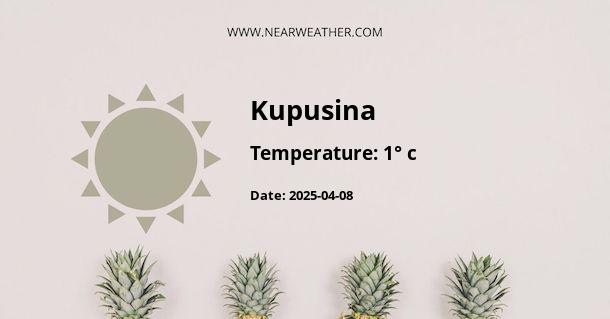Understanding the Climate and Weather Patterns in Kupusina, RS
Located in the autonomous province of Vojvodina within Serbia, Kupusina experiences a climate characterized by a blend of continental influences, which brings about distinct seasonal variations. Understanding the weather patterns of Kupusina throughout the year is crucial for residents, agricultural activities, and visitors planning trips to this region.
Geographical Influence on Kupusina's Climate
Kupusina's position in the Pannonian Plain greatly affects its climate. This geographical setting contributes to the relatively flat terrain and open spaces that allow cold air from the Eurasian landmass to move in during winter and warmer air from the south during the summer.
Seasonal Weather Overview
Winter
The winter months, from December to February, in Kupusina are typically cold and snowy. Average temperatures during this period hover around the freezing mark, but colder snaps can see temperatures plummet well below 0°C (32°F), especially during the night.
"Frigid winds known as the Košava can amplify the chilly conditions, making it feel even colder than the actual temperature," notes local weather expert Dr. Jovan Marković.
| Month | Average High (°C) | Average Low (°C) | Precipitation (mm) |
|---|---|---|---|
| December | 2 | -3 | 50 |
| January | 1 | -5 | 40 |
| February | 4 | -2 | 40 |
Spring
Spring offers a transitional period with increasing temperatures and longer days. From March through May, the weather warms up, and precipitation increases, fueling the growth of local flora.
- March witnesses a mix of late-winter chills and early signs of warmth.
- April sees an upturn in average temperatures, ranging from 8°C to 17°C.
- By May, conditions are considerably warmer, with averages from 13°C to 23°C.
Summer
The summer season, spanning June to August, is characterized by warm to hot conditions. Daytime temperatures often reach the high 20s Celsius (the 80s Fahrenheit), and sometimes even higher. However, this heat can be accompanied by swift and sometimes severe thunderstorms as the region taps into the moisture-laden air masses coming up from the Mediterranean.
- June starts the summer with an enjoyable warmth, promoting outdoor activities.
- July being the peak of summer, sees some of the highest temperatures of the year.
- August, although still warm, gradually transitions into cooler autumn weather.
Autumn
Autumn brings a noticeable cooling trend and increased precipitation. The weather becomes more unpredictable, with a mix of warm, sunny days and the arrival of cooler, wetter weather as the season progresses.
- September enjoys the leftover warmth from summer with cooling nights.
- October sees a more rapid decline in temperature and an increase in rainfall.
- November is significantly cooler, as winter starts to make its presence known.
Detailed Monthly Weather Data and Trends
An in-depth look at Kupusina’s monthly weather data reveals long-term trends that are paramount for agricultural planning as well as understanding potential climate change impacts.
Temperature Trends
Over the past few decades, temperature data has shown a gradual increase, aligning with the global trend of warming due to climate change. The highest temperatures are usually recorded in July or August, with occasional heatwaves pushing the mercury to 35°C (95°F) or above. Conversely, the coldest month is January, with daily lows averaging -5°C (23°F).
Precipitation Patterns
Rainfall distribution throughout the year is relatively even, with slightly drier conditions prevailing in the winter months. Snowfall occurs mainly from late December through February but can extend into March during colder years. The wettest month tends to be June, when convective storms are most frequent.
Climate Extremes and Records
Extreme weather events such as severe thunderstorms, hail, and strong winds occur periodically, particularly during the transition between seasons. Historical records show that temperature extremes have varied from lows of -20°C (-4°F) during winter cold spells to highs exceeding 40°C (104°F) during particularly intense summer heatwaves.
Agricultural Considerations and Climate Adaptation
Agriculture plays a significant role in the economy of Kupusina. Timing of planting and harvest is intrinsically linked to the seasonal patterns of temperature and precipitation. Farmers in the region have to account for the first and last frost dates to protect susceptible crops. Irrigation is essential during the drier months, and crop varieties are often chosen based on their tolerance to the area's peat-rich soils and the local climate's variability.
"Adapting to the changing climate is crucial for sustaining agricultural productivity in the Pannonian Plain," affirms Dr. Gordana Đurić, an agricultural scientist.
Climate Change Implications
Evidence suggests that climate change is altering weather patterns in Kupusina and surroundings. Shorter, milder winters and hotter, longer summers could become the norm. Increased variability in precipitation could lead to both flooding and drought. These changes necessitate forward-thinking in urban planning, agricultural practices, and water management to minimize the risks and utilize potential benefits.
Visitor Recommendations
If planning a visit to Kupusina, it is recommended to choose the period from late May to early September when the weather is most favorable for tourism. The warmth of summer caters well to those seeking to explore the natural landscapes and enjoy the region's cultural activities. Always check the local weather forecasts in advance, as conditions can still vary significantly during these months.
Understanding Kupusina's climate and weather year-round offers insight into the region’s natural dynamics and is essential for economic planning, agricultural success, and ensuring enjoyable visits to this unique area of Serbia. Thoughtful adaptation to the changing climate will help residents and stakeholder’s leverage opportunities for sustainable development in the years to come.
A - Kupusina's Latitude is 45.736111 & Longitude is 19.009720.
A - Weather in Kupusina is 4° today.
A - Climate Conditions in Kupusina shows overcast clouds today.
A - Humidity in Kupusina is 49% today.
A - Wind speed in Kupusina is 31.82 km/h, flowing at 149° wind direction. today.
